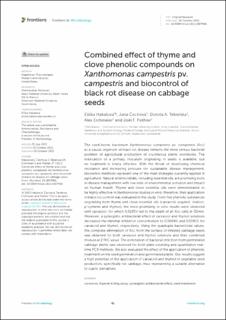Please use this identifier to cite or link to this item:
https://doi.org/10.21256/zhaw-26030Full metadata record
| DC Field | Value | Language |
|---|---|---|
| dc.contributor.author | Hakalová, Eliška | - |
| dc.contributor.author | Čechová, Jana | - |
| dc.contributor.author | Tekielska, Dorota A. | - |
| dc.contributor.author | Eichmeier, Ales | - |
| dc.contributor.author | Pothier, Joël F. | - |
| dc.date.accessioned | 2022-11-11T13:06:02Z | - |
| dc.date.available | 2022-11-11T13:06:02Z | - |
| dc.date.issued | 2022-01-08 | - |
| dc.identifier.issn | 1664-302X | de_CH |
| dc.identifier.uri | https://digitalcollection.zhaw.ch/handle/11475/26030 | - |
| dc.description.abstract | The seed-borne bacterium Xanthomonas campestris pv. campestris (Xcc) as a causal organism of black rot disease remains the most serious bacterial problem of agricultural production of cruciferous plants worldwide. The eradication of a primary inoculum originating in seeds is available, but no treatment is totally effective. With the threat of developing chemical resistance and increasing pressure for sustainable disease management, biocontrol methods represent one of the main strategies currently applied in agriculture. Natural antimicrobials, including essential oils, are promising tools in disease management with low risks of environmental pollution and impact on human health. Thyme and clove essential oils were demonstrated to be highly effective in Xanthomonas studies in vitro; therefore, their application in black rot control was evaluated in this study. From five phenolic substances originating from thyme and clove essential oils (carvacrol, eugenol, linalool, p-cymene and thymol), the most promising in vitro results were observed with carvacrol, for which 0.0195% led to the death of all Xcc cells in 30 min. Moreover, a synergistic antibacterial effect of carvacrol and thymol solutions decreased the minimal inhibition concentration to 0.0049% and 0.0195% for carvacrol and thymol, respectively. Using the quadruple bactericidal values, the complete elimination of Xcc from the surface of infested cabbage seeds was obtained for both carvacrol and thymol solutions and their combined mixture at 2 MIC value. The elimination of bacterial infection from germinated cabbage plants was observed for both plate counting and quantitative real-time PCR methods. We also evaluated the effect of the application of phenolic treatment on the seed germination and germinated plants. Our results suggest a high potential of the application of carvacrol and thymol in vegetable seed production, specifically for cabbage, thus representing a suitable alternative to cupric derivatives. | de_CH |
| dc.language.iso | en | de_CH |
| dc.publisher | Frontiers Research Foundation | de_CH |
| dc.relation.ispartof | Frontiers in Microbiology | de_CH |
| dc.rights | https://creativecommons.org/licenses/by/4.0/ | de_CH |
| dc.subject | Carvacrol | de_CH |
| dc.subject | Thymol | de_CH |
| dc.subject | Killing assay | de_CH |
| dc.subject | Synergistic antibacterial effect | de_CH |
| dc.subject | Seed treatment | de_CH |
| dc.subject.ddc | 579: Mikrobiologie | de_CH |
| dc.title | Combined effect of thyme and clove phenolic compounds on Xanthomonas campestris pv. campestris and biocontrol of black rot disease on cabbage seeds | de_CH |
| dc.type | Beitrag in wissenschaftlicher Zeitschrift | de_CH |
| dcterms.type | Text | de_CH |
| zhaw.departement | Life Sciences und Facility Management | de_CH |
| zhaw.organisationalunit | Institut für Umwelt und Natürliche Ressourcen (IUNR) | de_CH |
| dc.identifier.doi | 10.3389/fmicb.2022.1007988 | de_CH |
| dc.identifier.doi | 10.21256/zhaw-26030 | - |
| zhaw.funding.eu | Not specified | de_CH |
| zhaw.originated.zhaw | Yes | de_CH |
| zhaw.publication.status | publishedVersion | de_CH |
| zhaw.volume | 13 | de_CH |
| zhaw.publication.review | Peer review (Publikation) | de_CH |
| zhaw.webfeed | Umweltgenomik | de_CH |
| zhaw.funding.zhaw | Xhortomics: Entwicklung von diagnostischen und epidemiologischen Hilfsmitteln für die Xanthomonas hortorum Spezies Gruppe basierend auf OMICs Technologien | de_CH |
| zhaw.author.additional | No | de_CH |
| zhaw.display.portrait | Yes | de_CH |
| Appears in collections: | Publikationen Life Sciences und Facility Management | |
Files in This Item:
| File | Description | Size | Format | |
|---|---|---|---|---|
| 2022_Hakalova-etal_Combined-effect-thyme-clove-phenolic-compounds_fmicb.pdf | Article | 1.12 MB | Adobe PDF |  View/Open |
| 2022_Hakalova-etal_Combined-effect_Supplementary-Material.xlsx | Supplementary Material | 47.75 kB | Microsoft Excel XML | View/Open |
Show simple item record
Hakalová, E., Čechová, J., Tekielska, D. A., Eichmeier, A., & Pothier, J. F. (2022). Combined effect of thyme and clove phenolic compounds on Xanthomonas campestris pv. campestris and biocontrol of black rot disease on cabbage seeds. Frontiers in Microbiology, 13. https://doi.org/10.3389/fmicb.2022.1007988
Hakalová, E. et al. (2022) ‘Combined effect of thyme and clove phenolic compounds on Xanthomonas campestris pv. campestris and biocontrol of black rot disease on cabbage seeds’, Frontiers in Microbiology, 13. Available at: https://doi.org/10.3389/fmicb.2022.1007988.
E. Hakalová, J. Čechová, D. A. Tekielska, A. Eichmeier, and J. F. Pothier, “Combined effect of thyme and clove phenolic compounds on Xanthomonas campestris pv. campestris and biocontrol of black rot disease on cabbage seeds,” Frontiers in Microbiology, vol. 13, Jan. 2022, doi: 10.3389/fmicb.2022.1007988.
HAKALOVÁ, Eliška, Jana ČECHOVÁ, Dorota A. TEKIELSKA, Ales EICHMEIER und Joël F. POTHIER, 2022. Combined effect of thyme and clove phenolic compounds on Xanthomonas campestris pv. campestris and biocontrol of black rot disease on cabbage seeds. Frontiers in Microbiology. 8 Januar 2022. Bd. 13. DOI 10.3389/fmicb.2022.1007988
Hakalová, Eliška, Jana Čechová, Dorota A. Tekielska, Ales Eichmeier, and Joël F. Pothier. 2022. “Combined Effect of Thyme and Clove Phenolic Compounds on Xanthomonas Campestris Pv. Campestris and Biocontrol of Black Rot Disease on Cabbage Seeds.” Frontiers in Microbiology 13 (January). https://doi.org/10.3389/fmicb.2022.1007988.
Hakalová, Eliška, et al. “Combined Effect of Thyme and Clove Phenolic Compounds on Xanthomonas Campestris Pv. Campestris and Biocontrol of Black Rot Disease on Cabbage Seeds.” Frontiers in Microbiology, vol. 13, Jan. 2022, https://doi.org/10.3389/fmicb.2022.1007988.
Items in DSpace are protected by copyright, with all rights reserved, unless otherwise indicated.